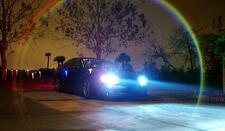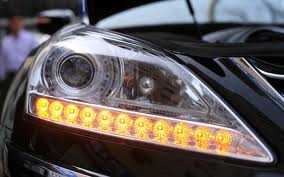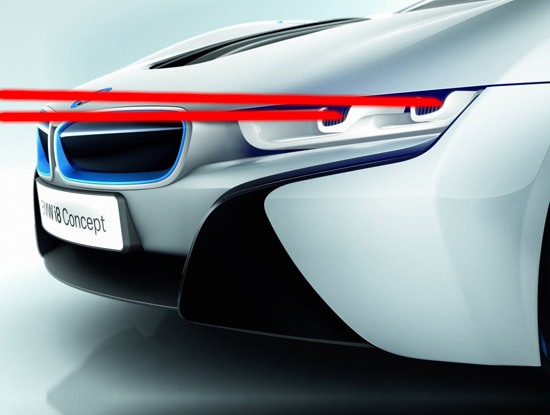Since the early 1990s, halogen or xenon HID (high intensity discharge) lamps have been the most widely chosen light source in motor vehicle headlamps. Although a great advancement since the design of reflector optics, HID lights come with mixed reviews: an appreciation for the improved nighttime visibility combined with a concern of the produced glare. HID lamps also require a relatively significant energy source, putting vehicle owners at possible financial risk for replacing car batteries and burnt-out bulbs more frequently.
for the improved nighttime visibility combined with a concern of the produced glare. HID lamps also require a relatively significant energy source, putting vehicle owners at possible financial risk for replacing car batteries and burnt-out bulbs more frequently.
Automotive HB LEDs
In the 1980s, light-emitting diodes (LEDs) began appearing in automotive brake lights. In the following two decades, LEDs spread to every light source on vehicles, except headlights. Since 2004, automotive headlamp manufacturers have been actively developing and using LEDs. Several car companies have switched to High-Brightness LEDs (HB LEDs) because these widgets require less energy, offering the possibility of extended vehicle battery life. HB LEDs also have a proven longer lifespan than their incandescent predecessors.
HB LED bulbs have been shown to produce more than double the luminous power of halogen lamps and approximately the same amount of luminous power as xenon bulbs. In a traditional incandescent bulb, most of the energy used converts to heat, and only 5% to light. With an LED light, about 20% of the energy is converted into light. This knowledge is most attractive for hybrid or electronic vehicle manufacturers, with some preliminary studies showing an efficient HB LED headlamp system can extend a vehicle’s range by nearly six miles (9.5 km).
LED lights are commonly more expensive per unit than incandescent bulbs. However, LEDs are much more durable (no filament in the bulb itself; it does not "burn out”) and have a significantly longer life span compared to incandescent bulbs. With proposed life spans of up to several decades, HB LED headlights have the potential to outlast a car itself! If aesthetics are important—as they are in automotive design—LEDs also offer a more sleek and compact light source allowing for more design-based headlamp placement. LEDs also allow unique beam patterns (light where you want it on the road and not in opposing driver’s eyes) and light color temperatures can be tailored to enhance night vision.
But don’t HB LEDs need to discharge heat? Automotive companies use R30 HB LED light bulbs, which have an aluminum “gill structure” (heat sink / radiator fins) to increase the surface area in order to dissipate the conductive heat generated from the HB LED application.
In addition to headlamps, LEDs are increasingly being adopted for signal functions such as brake lights and turn signals, as well as daytime running lamps; these applications offer significant advantages over filament bulbs with fewer engineering challenges.
Automotive Laser Diodes
It feels as though just as the word was out the LEDs could be the solution for energy use, lifespan and design challenges faced by automotive headlamp manufacturers, we are hearing more about car companies who are contemplating the usage of Laser Diode headlights.
 Some automotive manufacturers have declared that laser diode headlamps require even less energy than HB LEDs, which further lowers the power needs from a car battery. Laser diode applications consist of monochromatic wavelengths spread with phosphor, which creates a more natural lighting than laser alone, but still upholds the energy efficiency desired by a car manufacturer or owner.
Some automotive manufacturers have declared that laser diode headlamps require even less energy than HB LEDs, which further lowers the power needs from a car battery. Laser diode applications consist of monochromatic wavelengths spread with phosphor, which creates a more natural lighting than laser alone, but still upholds the energy efficiency desired by a car manufacturer or owner.
Laser diode light fixtures create a more targeted point of light, which may increase visual safety for the drive all while limiting the offensive glare often experiences with halogen lights.
What do you think?
- Do you think laser diode headlights will be more energy efficient than the proven efficiency of HB LEDs?
- Do you think the expected life of laser diode automotive lights will withstand real-world environments, such as extreme high and low temperatures, ice freeze, and short and long power cycles?
- How soon do you think laser diode lighting can surpass the automotive LEDs?
Jessica Sylvester
Marketing Communications
Palomar Technologies
